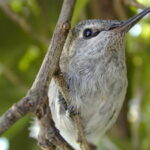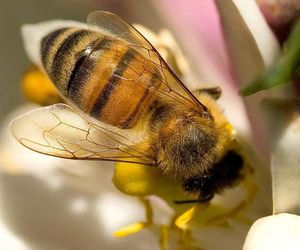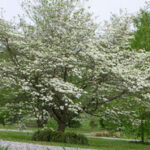For the serviceberry tree (Amelanchier, by its botanical classification), timing is everything. When it blooms, quite early in spring, its white flowers are pretty much the only show in town. The serviceberry’s pals in the understory, the redbud and dogwood, won’t delight onlookers with their blossoms for another few weeks.
The serviceberry provides food for all sorts of wildlife. In early spring, it is one of the few nectar sources for bees and butterflies. Its dark purple berries, which ripen in June, attract many songbirds and small mammals. Deer happily browse on the twigs and stems. Critters often break off branches as they snack and thereby contribute to the misshapen appearance of many wild serviceberry trees, already spindly from bending around larger trees toward the sun.
An Excellent Choice for the Garden
But give that little tree some TLC and it morphs into a landscape gem. Well-shaped, the pampered serviceberry has thick clusters of white flowers in early spring, an abundance of dark berries in early summer and apricot or bronze foliage in the fall. Because it rarely grows to more than 30 feet, it fits readily into the garden landscape. Unlike many other ornamental trees chosen for the garden, the serviceberry — precisely because it is a North American native — thrives with a minimum of fussing.
Versatility
Amelanchier is hardy. Its subtypes can be found from USDA Zone 3 to Zone 10. In other words, some varieties of serviceberry can endure winter temperatures as low as 40 below (F), while others can handle Miami’s steamy climate.
Serviceberry trees grow on rocky slopes, in prairies, on creek banks, at 8,000 feet of elevation and on low-lying coastal plains. Although it prefers sunny spots, the tree can make do with partial shade.
Berries for Human Use
A cousin of the apple tree, Amelanchier has fruit that is often likened to apples. The pea-sized berries are both sweet and juicy.
This sampler of wild edibles has lived in close proximity to serviceberry trees for 25 years and never once picked a ripe berry from those trees. The birds always beat me to it. Adding to the harvester’s challenges is the gradual nature of the ripening process, so that a single day’s picking is often minimal. That challenge can be overcome by freezing the early pickings and then waiting until a sufficient quantity has accumulated for serviceberry jam or pie.
Medicinal and Other Uses
Using serviceberry bark, American Indians brewed a tea to ease stomach ailments, address gonorrhea symptoms and speed post-partum healing. Other herbals tout the serviceberry’s utility in expelling worms from the GI tract.
Indians and white settlers alike valued the hardness of serviceberry wood, weighing 49 pounds per cubic foot. Serviceberry arrows, spear shafts and tool handles stand up to considerable force without breaking.
What’s in a Name?
The tree’s serviceability is not the reason for its name. According to one story, serviceberry is so named because its blooming coincided with the early spring plethora of funeral services, held for people who died during the winter months when the ground was too frozen for burials.
Many New Englanders call the serviceberry a shadblow. One of the most common types of serviceberry, the shadblow can be found throughout the Eastern seaboard, from Nova Scotia to north Florida. The shadblow blooms about the same time as shad swim upstream to spawn.
Sources:
http://umaine.edu/publications/2563e/
www.thetreefarm.com/serviceberry-shadblow
www.csmonitor.com/The-Culture/Gardening/diggin-it/2011/0630/Enjoy-the-fruit-from-the-serviceberry-tree
www.wvencyclopedia.org/articles/284









